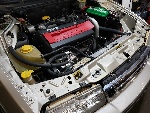
[Subscribe to Daily Digest] |
I’ve got some comparison results for several BPV/DVs, as well as some observations. As always, please ask questions, challenge theories, & point out errors & omissions.
The valves tested:
1) Stock Bosch 0280142103; this is the older model, without the brass seating disk added to the diaphragm in the later -110 model. (For a comparison of the internals of the newer Bosch valves, see the link.)
2) Forge DVR; their diaphragm “race” model, sort of like an adjustable, rebuild-able Bosch valve.
3) Forge DVS007P; their latest aluminum-piston/O-ring “stubby” model, w/two O-rings sealing against the piston & one sealing the spring chamber.
All of these valves are similar in their design, in that they recess the vacuum nipple down into the center of the spring, thereby reducing the volume required for vacuum & increasing the valve’s quickness.
The car used:
1999 9-3SE, auto tranny, 185 hp, K&N air filter, ported TBTC & removed turbo silencer, stock exhaust system & doubled-back IC.
The tests:
I first tested each valve’s sealing/opening abilities with a Craftsman hand-operated vacuum pump & gauge. Similar to the tests run in “The Great Diverter Valve Face-Off,” I tested for the amount of vacuum required for three conditions:
1) the initial point where I could get very low pressure to leak thru the valve (I blew into both ports!)
2) the point where light would first show as the valve opened
3) the full open position
Each valve was tested at approximately 70°F & run a minimum of three times for consistency. I then installed them on my car & observed their characteristics under normal idle (approx. 900rpm) & fast idle (approx. 1200rpm) conditions, & ran them all in both the stock & rotated positions for repeated 1/4-mile straight runs.
The vacuum results:
Bosch -103:
Leak: 7in/190mm Hg
Light: 9in/240mm Hg
Full: 17.5in/440mm Hg
Forge DVR:
Green (weak) spring:
Leak: 4in/100mm Hg
Light: n/a
Full: approx. 18in/460mm Hg
Blue (strong) spring:
Leak: 17in/430mm Hg
Light: n/a
Full: >22.5in/>565mm Hg
Forge DVS007P:
Green (weak) spring:
Leak: 4in/100mm Hg
Light: 6in/125mm Hg
Full: 11in/290mm Hg
Blue (strong) spring:
Leak: 6in/125mm Hg
Light: 8in/200mm Hg
Full: 17.5in/440mm Hg
Vacuum test observations: All the valves held vacuum with zero loss for as long as I wanted (no less than 30 seconds). All leak tests were done by blowing into both ports of the valves, & I quickly discovered that the side port always leaked first. The DVR’s design places the diaphragm out of view of the side port (unlike the Bosch valve), so there’s no way to tell when light shows thru. With the blue spring in the DVR, my vacuum pump would only evacuate up to 22.5in Hg (even though the gauge goes to 30in). By blowing thru the ports, I could tell that it wasn’t yet fully opened (i.e., there was more restriction than with the green spring at full open). Piston travel on the DVS007P was not smooth with either spring (unlike the diaphragm’s travel), but, as illustrated in the idle tests, I don’t know that it’s a concern since the engine generates lots more vacuum than my puny pump.
The idle results:
I swapped out all three valves & two spring combinations. I observed the valves as I attached the vacuum line at normal idle, & continued to observe as a helper raised the idle slightly.
Bosch -103: The diaphragm opened about 2/3 of full open at normal idle, & then opened fully at fast idle. When idle was return to normal, the diaphragm returned to 2/3 open. The diaphragm had a pronounced, trampoline-like bounce during normal idle, & only a slight bounce at fast idle.
DVR, green spring: The diaphragm opened some amount at normal idle, then some more at fast idle, then less again when returning to normal idle. There was a slight amount of bounce under normal idle but much less than what occurred with the Bosch. There was no bounce at fast idle.
DVR, blue spring: The diaphragm was fully closed at normal idle. At fast idle, there was some opening. The diaphragm closed fully when returning to normal idle. There was no noticeable bounce.
DVS007P, green spring: The piston snapped full open at normal idle. There was no change going to fast idle or back to normal idle.
DVS007P, blue spring: The piston opened about 3/4 of full open at normal idle, & then opened fully at fast idle. It stayed full open when idle was returned to normal, & there was no bounce to the piston.
All of the valves snapped shut when the vacuum line was removed.
The driving results:
With my auto tranny & stock, restrictive exhaust & IC, I could tell no difference in the 1/4-mile runs I made. I did both standing starts (accelerating up to 6,000rpm) & rolling on/off accelerations. Rotating the valves (pressure in to side or in to bottom), changing the springs, or swapping valves altogether made no difference in the quickness, boost level or speed of the car. I made at least three runs with each setup. (Based on the vacuum & idle results of the DVR using the blue spring, I decided not to run this combination in my driving tests.)
Other observations:
While I was running the idle tests, I tried getting a piece of paper about 1&1/2” square to cling to the open port of the valves. It never would, telling me that little, if any, air gets pulled in thru this open positive-pressure port during idle.
The tendency of all the valves to seal better with pressure coming into the bottom port means that all of them should probably be run this way. I have emailed both Bosch & Saab asking about this, but have not received an answer from either company. In the case of the DVR, the instructions actually say this is the preferred orientation, & will "prolong the life of the diaphragm." (There’s no further explanation, but my guess is that high-pressure air blowing sideways across the diaphragm’s face creates a high frequency “flapping,” allowing greater opportunity for abrasions & holes. (Is this why Bosch added their brass disk?) With the air coming straight on against the diaphragm’s face, the diaphragm’s pushed away from the port & against the protective inner cap.) In the case of the DVS007P, the fact that the piston slides along this bottom port's axis (rather than collapsing away from the port like a diaphragm does) means that high-pressure air blowing in from the side creates uneven loads across the piston. Imagine riding a bike with a tailwind versus riding in a buffeting crosswind. With a tailwind, straight-line travel is effortless. But with a crosswind, every time you’re hit with a big side gust your straight-line travel gets messed up. Orienting it with the pressure coming into the bottom port ensures that it always has in-line assistance/resistance when opening & closing.
Preferences:
In my opinion, the biggest advantages (for my application) are the adjustability & rebuild-ability designed into these aftermarket valves. (If I had a manual transmission, less restrictive intake/exhaust, & boost/ECU modifications, I might realize other benefits as well.) Realistically, the stock valve should probably be considered a “maintenance item” &, like belts, be replaced at distant regular intervals.
So what are the trade-offs? Well, even though the Bosch valve isn’t of the latest design, it’s still sealing & working fine after nearly 5yrs & 43k miles. It’s a low-cost, no-worry part.
The DVR is more expensive, but it has the additional advantages of being rebuild-able & adjustable, thereby decreasing its long-term costs & increasing its versatility. Got a diaphragm leak? Unscrew the top, throw in a new diaphragm, & you’re good to go. Upped your boost & now your DV is leaking at peak? Unscrew the top, throw in a stronger spring, & you’re boostin’. The best part? The DVR already comes with a spring assortment & extra diaphragms, so there’s no buying extra parts, finding distributors, or waiting for deliveries! And with diaphragm valves, there’s less mass to move (for quicker reaction) & no parts to clean/re-grease (for more consistent operation & less hassle). Its design also gives the DVR the shortest travel & most spring compression of any of the valves. With the green spring, this looks like the ideal setup to replace the stock valve, giving quicker response, adjustability, low maintenance & inspection/repair capabilities. My only concern is the design’s apparent restriction in airflow, but since I didn’t run any flow tests I don’t know how valid my concern really is.
The DVS007P is a little different, since it’s a piston valve. Basically, it’s indestructible but requires more attention than a diaphragm valve. Old, dried grease will decrease its performance, & if you’re not into maintenance it’s just another thing to remember (or forget?) to do. Inspecting it at every oil change is probably a good idea. The O-rings can be damaged if you’re not careful, but replacements are cheap & widely available. The thing I like about this design is its wide-open bypass chamber. There are no obvious flow restrictions, & that’s what I want for my diverter valve. The good news for this model is that Forge now offers an "adjustability kit" to tune the valve to your engine’s characteristics. I really like this concept for the reduced cost & complexity compared with other adjustable valves. It also makes a lot more sense to me than a design that uses a single spring but then requires the user to add or remove washers. (This can possibly compromise the operation of the valve by changing the spring's available compression distance (not allowing the valve to open fully) & altering the distribution of mass in the moving parts (reducing the valve's responsiveness).) With the green spring, the DVS007P will give the quickest “free-wheeling” turbo impeller of any of these valves, while the blue spring puts you into a nearly identical setup as the stock Bosch valve but with less flow restriction & a “bullet-proof,” lifetime part.
-Greg
posted by 216.160.177...
No Site Registration is Required to Post - Site Membership is optional (Member Features List), but helps to keep the site online
for all Saabers. If the site helps you, please consider helping the site by becoming a member.
 |
 |
 |
 |
 |



